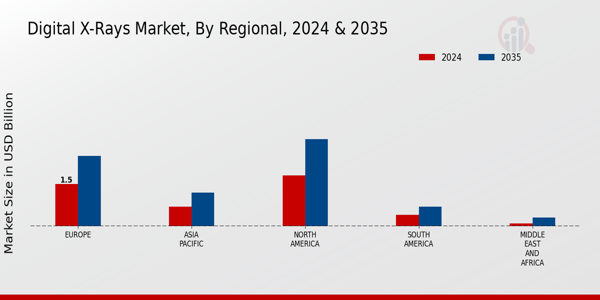Market Growth Projections
The Global Digital X-Rays Market Industry is projected to experience substantial growth in the coming years. With a market value of 4.5 USD Billion in 2024, it is expected to reach 7.8 USD Billion by 2035, reflecting a robust demand for digital imaging solutions. The anticipated compound annual growth rate (CAGR) of 5.13% from 2025 to 2035 indicates a steady expansion trajectory. This growth can be attributed to various factors, including technological advancements, increasing healthcare expenditures, and a rising emphasis on diagnostic accuracy. The market's positive outlook suggests a promising future for stakeholders in the Global Digital X-Rays Market Industry.
Technological Advancements
The Global Digital X-Rays Market Industry is experiencing rapid growth due to continuous technological advancements. Innovations such as portable digital X-ray machines and advanced imaging software enhance diagnostic accuracy and efficiency. For instance, the integration of artificial intelligence in image analysis has shown promise in improving detection rates of various conditions. As a result, the market is projected to reach 4.5 USD Billion in 2024, with an anticipated growth trajectory driven by these advancements. The increasing demand for high-quality imaging solutions in healthcare settings further supports this trend, indicating a robust future for the Global Digital X-Rays Market Industry.
Growing Geriatric Population
The Global Digital X-Rays Market Industry is significantly impacted by the growing geriatric population worldwide. As individuals age, the prevalence of chronic diseases and conditions requiring diagnostic imaging increases. This demographic shift necessitates the adoption of advanced imaging technologies, including digital X-rays, to ensure timely and accurate diagnoses. The increasing life expectancy in many regions further exacerbates this trend, leading to a higher demand for healthcare services. Consequently, the market is expected to expand, reflecting the urgent need for effective diagnostic solutions tailored to the needs of an aging population, thereby enhancing the Global Digital X-Rays Market Industry.
Government Initiatives and Funding
Government initiatives and funding play a crucial role in the expansion of the Global Digital X-Rays Market Industry. Various countries are investing in healthcare infrastructure, particularly in diagnostic imaging technologies. For example, government programs aimed at enhancing healthcare accessibility often include provisions for upgrading medical imaging equipment. These initiatives not only improve patient care but also stimulate market growth. The projected compound annual growth rate (CAGR) of 5.13% from 2025 to 2035 underscores the positive impact of such government support on the Global Digital X-Rays Market Industry, as it encourages further innovation and adoption of digital X-ray systems.
Rising Demand for Diagnostic Imaging
The Global Digital X-Rays Market Industry is significantly influenced by the rising demand for diagnostic imaging services. As healthcare providers increasingly rely on accurate imaging for patient diagnosis and treatment planning, the adoption of digital X-ray systems is on the rise. This trend is particularly evident in emerging economies, where healthcare infrastructure is rapidly developing. The market is expected to grow to 7.8 USD Billion by 2035, reflecting the increasing emphasis on early disease detection and preventive healthcare. Consequently, the Global Digital X-Rays Market Industry is poised for sustained expansion, driven by this growing demand for effective diagnostic tools.
Increased Focus on Preventive Healthcare
The Global Digital X-Rays Market Industry is benefiting from an increased focus on preventive healthcare. Healthcare systems worldwide are shifting towards proactive measures to identify health issues before they escalate. Digital X-rays play a pivotal role in this paradigm shift, enabling early detection of diseases such as cancer and osteoporosis. This proactive approach not only improves patient outcomes but also reduces long-term healthcare costs. As a result, the market is likely to witness sustained growth, with projections indicating a rise to 7.8 USD Billion by 2035. The emphasis on preventive healthcare is thus a key driver of the Global Digital X-Rays Market Industry.























Leave a Comment